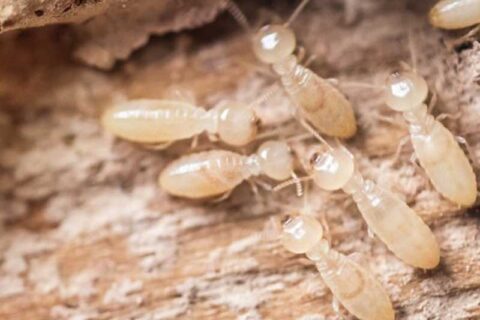Prepping for Whole House Fumigation and Its Process
Whole House Fumigation
If you have a termite infestation, your goal is likely to get rid of these little home-wrecking pests as quickly as possible. Termites do billions of dollars of damage to homes across the United States each year, and the result can be extensive and costly repairs. There are different types of termites, and if you have subterranean termites, the termite control measures your termite control company recommends should not include fumigation. This is because subterranean termites don’t live inside the house, but travel back and forth from underground colonies some distance away. I you have drywood termites, though, you are dealing with pests that live entirely within the wood they are consuming. In this case, pest removal will probably involve the tenting process, as fumigating the house is the best way to ensure that you reach each termite living within your home’s wood. Here, we offer a rundown of the ins and outs of tenting and fumigation, including the safety precautions and steps you will need to take for home protection.
Is Fumigation Safe?
Rest assured, termite exterminators must be trained and certified in order to perform fumigation, and the Environmental Protection Agency regulates the process. You will need to be out of your home, with your plants and animals away from the premises as well, and you will also need to take additional precautions. Once the tent is removed from the house, though, the fumigant will begin to dissipate. After six hours or so, the house will be tested for traces of fumigant, and your family will not be allowed to return until the level is low enough to be safe.
Fumigation Steps Explained
A house being fumigated must be tented, which means it will be encased in a specialized tarp or tent, meant to contain the fumigant in the house, allowing it to reach each crack and crevice. While your home is in this enclosed area, the fumigant will penetrate the wood and other porous surfaces in the house, reaching termites that are hiding or building nests within it. Once the termite professionals have encased your home in this tent, the fumigant, a true gas, will be released. The fumigation process will normally take between 32 and 72 hours, and will need to be rescheduled if it is likely to for high winds. Because the fumigant is a gas, will dissipate after the tent is removed, allowing you to return home safely.
What to Do Before it Begins
Fumigation is a major undertaking, and you will need to do your part ahead of time, to prepare your home and keep your family safe. Your termite control company will provide you with a checklist, but in general, these are the steps you must take, for personal and structural preparation.
- Have your gas company shut off the gas. The fumigation company will call your gas company, because the gas must be turned off before fumigation can begin. Additionally, any source of heat in your home, including heaters, appliances, and even computers, must be turned off and unplugged. Make sure that, in addition to having gas service suspended during fumigation, you turn off all pilot lights. As the homeowner, you will be responsible for contacting your gas company to come and turn the gas back for after the fumigation is completed.
- Remove all living things from the house. Plants, animals, and people need to be removed from the vicinity of the house. In other words, even if your cats live outside and your yard is fenced for your dogs, they need to be removed from the property. Even in the yard, they would be exposed to the fumigant, so protecting them means taking them away from the property. If you can’t carry all your houseplants away with you, you can move them several feet away from the exterior of the house. Don’t forget to take your fish! Fumigant can adversely affect the entire aquarium environment.
- Take out all of the perishables, and safeguard other food. Every perishable food item, including your pet food and whatever is in your refrigerator and freezer, must be removed from the house or double-bagged in specially designed fumigation bags. If you want to leave items in your pantry, things like rice and cereal must be double bagged as well, even if they are unopened. The only exceptions are items that are canned or bottled and haven’t been opened.
- Safeguard your medications. Medications you regularly take should be kept with you. Any other vitamins, over-the-counter medications, or prescriptions must be removed from the house or double-bagged, even if they are unopened. Don’t forget things like cough drops when you are safeguarding your medicines.
- Tend to the landscaping. Start by pruning plants and shrubs close to the house, then thoroughly watering the perimeter of the home. These measures will protect the plants from exposure to the fumigant. You will also need to rake back gravel and mulch from around the foundation, to expose the exterior of the foundation and make room for the tenting. Additionally, exterior devices like antennae, weathervanes, chimney stacks, and mechanical awnings will all need to be removed or lowered, for the tenting to be effective.
- Make sure everything inside the house is open. The doors between rooms, cabinet doors, closets, attic and basement doors, appliance doors, and safes must all be open, to allow circulation of the fumigant. You will also need to raise the blinds, open the drapes, and open all drawers in cabinets, dressers and desks. Any plastic covering items in the home, like furniture covers or mattress covers, must be removed. This includes plastic dry-cleaning bags and the lids to plastic storage totes. The reason for this is that fumigant can get trapped under plastic, and then it won’t dissipate from your house as it is supposed to, once the treatment is over.
- Leave your keys. While you are away, the fumigator will need to be able to access every part of your house. After the tent is in place, the house will be locked, and a secondary locking system will be used to keep anyone else from entering during fumigation.
- Stay away. You will not be able to enter the home again, for any reason, until the fumigation is complete, and the fumigant has dissipated. The home will be released for re-entry by the fumigation company, and a “clear to enter” notice will be posted on the house. Hold onto that notice, because you will need to show it to the utility company representative in order to have your gas turned on again.
Contact MightyMite Termite Services for Help
When termites have invaded your home, call the professionals at MightyMite Termite Services. We will be able to help you find the right solution, whether it’s treating the house with low toxicity products or going for a full house fumigation. We don’t take our job lightly or fumigate unnecessarily, but we strive to tailor our strategies for each individual home, finding exactly the right fit. At MightyMite, we’ve earned a reputation as experts in California termite control. We perform termite inspections to ensure that your home is free of termites and work hard to help you keep it that way, using treatments that are naturally derived and have a low impact on the environment. We diagnose and treat infestations with the most effective methods and unmatched warranties, solving your termite problems the first time, with an industry best “no call-back rate.” That, combined with our experience, and highly trained, licensed and professional staff, makes us the leading extermination company in the Bay Area. We understand that your home is your most important investment, so we work hard to provide excellent service, utilizing best practices to solve our customers’ termite problems. For more information, email Info@mightymitetermite.com, call us today at 408.335.7053, or contact us through our website.









